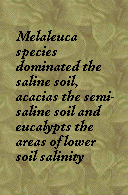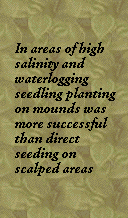
Jack Mercer (revegetation consultant working from Albany)

|
Takalarup Creek revegetation trial
Jack Mercer (revegetation consultant working from Albany) |
 |
Background
Jack Mercer carried out various treatments on the site for the purpose of demonstrating the rehabilitation of salinised riparian zones. Direct seeding by hand of mainly local native species was carried out over variable soil types and soil salinity levels. The treatments included scalping to a depth of 5 centimetres to remove weeds and weed seeds and ripping to a depth of 40-50 centimetres, mounding and ripping, herbicide treatments and burning.
Mounding and ripping were also carried out and then the mounds were left until rain had flushed out the salt. Most of the mounds were planted with seedlings, although some were also direct seeded. Weed control using herbicides was carried out after the first rains of winter. Ash beds were created by burning some standing and fallen dead timber in a hot autumn fire; direct seeding was then carried out in the ash beds. Jack compared the germination densities and uniformity of distribution between the various treatments in 1995 and reassessed the site in 1999.
Results
Other factors influencing the results were soil types and soil salinity levels, with sandy pale silty loams recording the highest germination. This was followed by the germination recorded on the ashbeds. Salinity levels above 100 milliSiemens/metre (mS/m.) to 50 centimetre soil depths were found to negatively affect the germination density. In 1999, species diversity, however, was highest (28 species in a 25 square metre quadrat) where salinity was 115 mS/m. Rainfall also affected germination with low winter rainfall causing late and reduced germination and also the death of emerging seedlings. Good spring and late December rains increased the survival rates of both the planted seedlings and the direct seeded area. Grazing from sheep and kangaroos was found to negatively affect the results in one area. Other factors that affected germination included waterlogging and pockets of weed competition. In 1995 Jack found evidence of self-selection when he looked at species distribution over the various soil salinities. Melaleuca species dominated the saline soil, acacias the semi-saline soil and eucalypts the areas of lower soil salinity. He believes that the availability of moisture and variation of soil types would also have influenced the self-selection process. When he reassessed the site in 1999 the pattern of species distribution had remained much the same except where eucalypts appeared to have been displaced by a late germination of vigorous growing Acacia cyclops. In saline areas A. cyclops had also become established but had not displaced the melaleucas. In 1999, those areas dominated by acacias and melaleucas generally displayed the best habitat value in the revegetation. In areas of high salinity and waterlogging seedling planting on mounds was more successful than direct seeding on scalped areas. Failures of direct seeding were attributed to intermittent stock grazing, low winter rainfall after seeding in 1995 and inappropriate soil preparation. The scalping and ripping of a section of the site in heavy soils prior to seeding caused a hardpan to form which impeded germination. Outcomes and recommendations Since the creek was fenced to exclude stock there has been a natural regeneration of flooded gums on disturbed weed-free soils. These germinants have established from seed set from the mature remnant trees in the riparian zone. There has also been strong colonisation of the native rush (Juncus species) that is tolerant to brackish conditions.
Steve Janicke (Department of Environment) has been following this project and says: "The progress of this revegetation trial has been interesting and informative to watch. Currently the riparian reserve is quite narrow with an open and flat-bottomed main channel through the rehabilitated reach. The banks were destabilised by the earth moving machinery used for site preparation, but now appear quite stable. The channel bed has been rapidly colonised by a dense carpet of salt-water couch. This should not impede flood flows greatly and will provide bed armouring. An unknown quantity is how well the channel can carry discharge from large, local storm events (the catchment is quite small). The channel above the trial site is quite incised and there is evidence of gully erosion and general instability in existing peripheral waterways. The road crossing is a control on the stream discharge and will tend to promote sediment deposition immediately upstream. Channel incision is occurring at the lower end of a small tributary that joins the main stream just below the revegetation trial indicating that the surrounding land is susceptible to erosion from runoff. The effect of severe storm flooding is unknown as yet. Narrow well vegetated reserves can divert over-bank flows. This remains to be seen, but the trial will provide a useful reference site for comparing channel morphological issues with vegetative rehabilitation." |
 |
|
 |
|